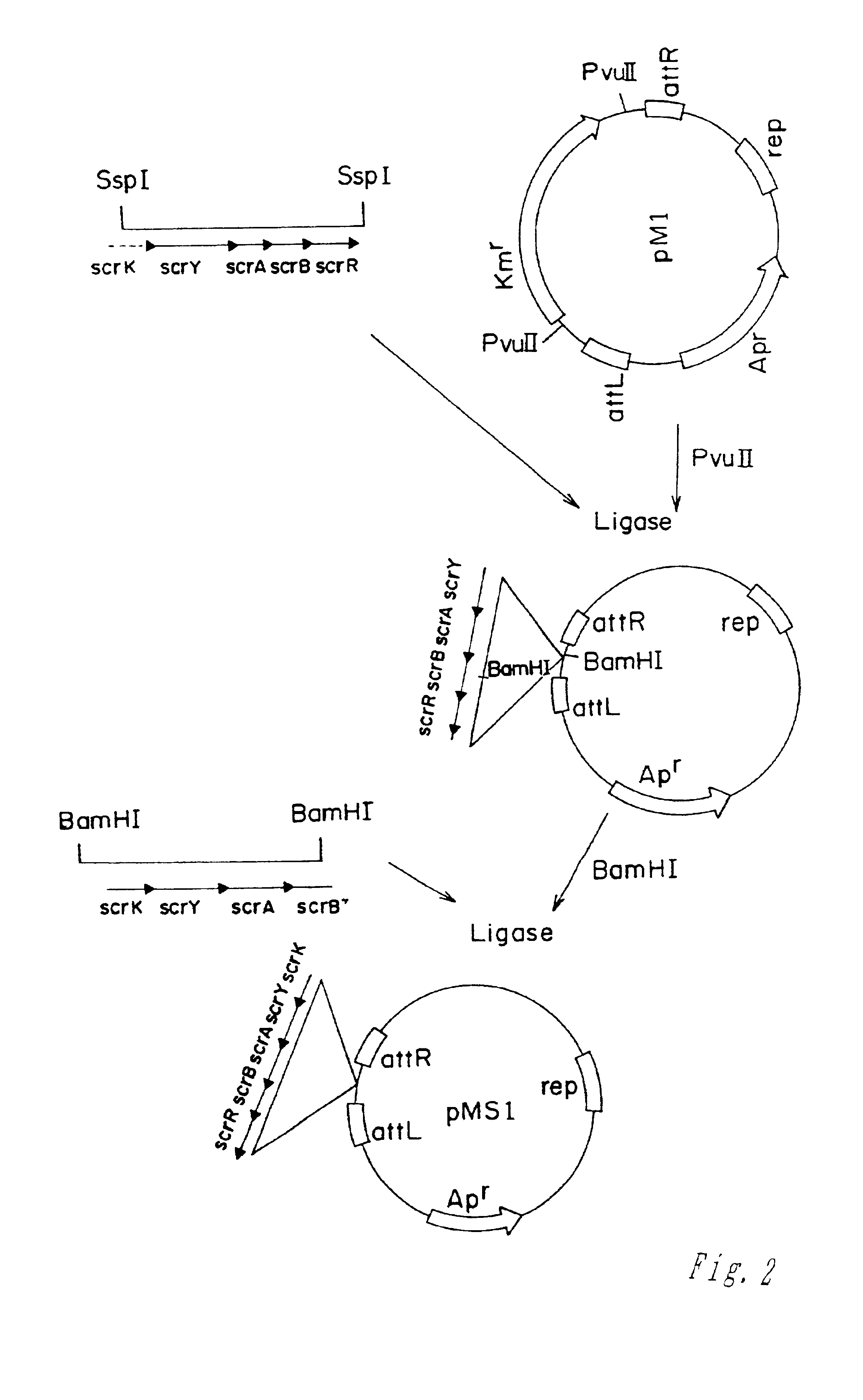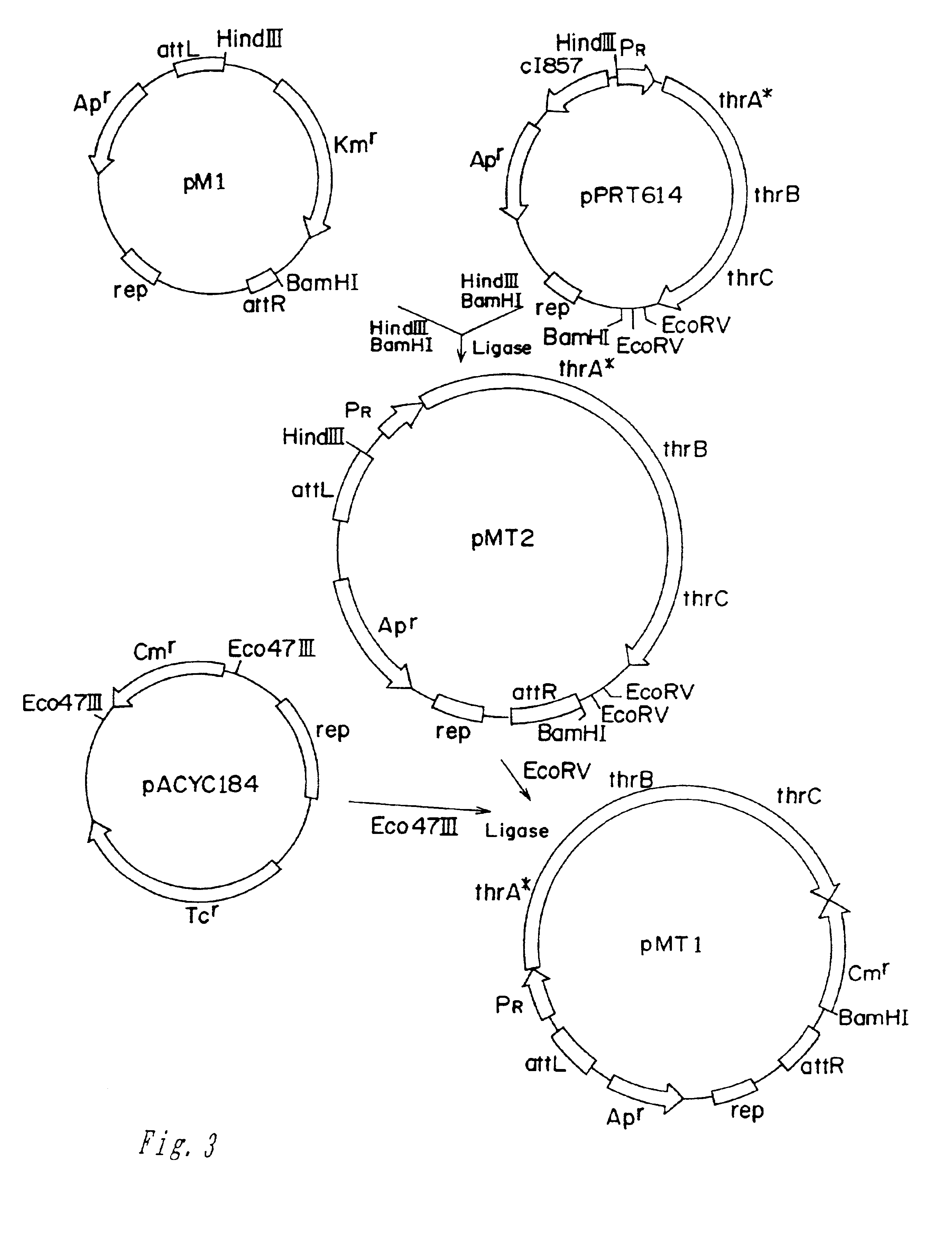Methods of making amino acids using E. coli transformed with csc genes
a technology of csc genes and amino acids, applied in the field of biotechnology, can solve the problems of inability to utilize sucro, limited yield of these metabolites, and approach that was never used before for amino acids, and achieve the effect of efficient production from sucros
- Summary
- Abstract
- Description
- Claims
- Application Information
AI Technical Summary
Benefits of technology
Problems solved by technology
Method used
Image
Examples
example 1
Preparation of the Donor of Sucrose Non-PTS Genes and PTS Genes
(1) Sucrose PTS Genes
[0053]The strain VD1 was used as a donor of PTS sucrose utilization (scr) genes. This strain was obtained as follows. The transposon Tn2555 carries the scr genes (Doroshenko et al., 1988. Molec. Biol., 22:645-658). The restriction analysis and partial sequencing revealed that the scr genes of Tn2555 are identical to those of pUR400 (accession numbers: EMBL X61005; EMBL X67750, GB M38416) that control sucrose transport and metabolism via PTS system.
[0054]The scr genes of Tn2555 were cloned into pM1, a mini-Mud vector pMu4041 derivative, obtained by the deletion of Mu-phage genes encoding transposase and repressor (M. Faelen. Useful Mu and mini-Mu derivatives. In: Phage Mu. Symonds et al., eds. Cold Spring Harbor Laboratory, New York, 1987, pp.309-316). This was performed in two steps. At the first step the SspI fragment of pBRS5.2 (pBR325::Tn2555) (Doroshenko et al., 1988. Molec. Biol. 22: 645-658) co...
example 2
Preparation of the E. coli Threonine Producing Strain Capable to Utilize Sucrose and Threonine Production Using the Strain (1)
[0061]As a recipient strain to which the PTS genes were introduced, E. coli VL643 was newly constructed as follows.
[0062]The known strain E. coli MG442 (Guayatiner et al., Genetika (in Russian), 14, 947-956 (1978), VKPM B-1628) was transduced the rhtA23 mutation from the strain 472T23 / pYN7 (VKPM B-2307) to obtain VL643 strain. The rhtA23 is a mutation which confers resistance to high concentration of threonine (>40 mg / ml) or homoserine (>5 mg / ml), and improves threonine production (ABSTRACTS of 17th International Congress of Biochemistry and Molecular Biology in conjugation with 1997 Annual Meeting of the American Society for Biochemistry and Molecular Biology, San Francisco, Calif. Aug. 24-29, 1997, abstract No. 457).
[0063]Thus obtained threonine-producing strain VL643 was infected with phage P1vir grown on the donor strain VL478. The transductants were sele...
example 3
Preparation of the E. coli Threonine Producing Strain Capable to Utilize Sucrose and Threonine Production Using the Strain (2)
[0068]As a recipient strain to which the PTS genes were introduced, E. coli VL2055 was constructed.
[0069]E. coli VL2055 was derived from the known E. coli strain VKPM B-3996 (U.S. Pat. No. 5,705,371). The strain B-3996, of which host strain is E. coli TDH-6, is deficient in thrC gene and is sucrose-assimilative, in which ilva gene has a leaky mutation. The strain B-3996 harbors the plasmid pVIC40 which had been obtained by inserting thrA*BC operon including thrA* gene encoding AKI-HDI which was substantially desensitized inhibition by threonine into RSF1010-derived vector.
[0070]From the strain B-3996, VL2055 was constructed in the following two steps.
[0071]Initially the plasmidless derivative of the strain VKPM B-3996, TDH-6, was selected after spontaneous elimination of pVIC40 plasmid. Next, a mutation inactivating kan gene of the Tn5 transposon inserted int...
PUM
| Property | Measurement | Unit |
|---|---|---|
| temperature | aaaaa | aaaaa |
| temperature | aaaaa | aaaaa |
| temperature | aaaaa | aaaaa |
Abstract
Description
Claims
Application Information
 Login to View More
Login to View More - R&D
- Intellectual Property
- Life Sciences
- Materials
- Tech Scout
- Unparalleled Data Quality
- Higher Quality Content
- 60% Fewer Hallucinations
Browse by: Latest US Patents, China's latest patents, Technical Efficacy Thesaurus, Application Domain, Technology Topic, Popular Technical Reports.
© 2025 PatSnap. All rights reserved.Legal|Privacy policy|Modern Slavery Act Transparency Statement|Sitemap|About US| Contact US: help@patsnap.com



